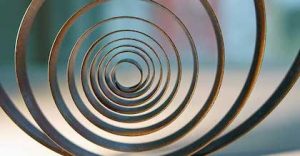 Constant-force springs are mechanical devices used in applications that typically require some kind of counterbalancing or retraction mechanism. In design and function, constant-force springs differ from the more common familiar types of wound springs. They exert a consistent linear force or torque that remains constant over a large range of motion.
Constant-force springs are mechanical devices used in applications that typically require some kind of counterbalancing or retraction mechanism. In design and function, constant-force springs differ from the more common familiar types of wound springs. They exert a consistent linear force or torque that remains constant over a large range of motion.
When a helical spring is in a stressed state, whether extended, compressed, or rotated, it produces a force proportional to its extension. How a spring responds when force is applied or released is referred to as spring deflection. Years of experience have taught us what to anticipate upon releasing the spring from its temporary state. We know that the spring will return to its original position, but it will do so in proportion to the amount of force applied to it before it is released. Springs have a restoring force that allows the elastic material to return to its original state—to a position of equilibrium—after the applied force has been removed.
Stretched, squeezed or twisted, what makes a helical spring a spring is its proportional restorative force. That is according to Hooke’s Law, named for the seventeenth-century British physicist Robert Hooke, who made the discovery. Essentially, the law describes the linear relationship that states that the amount of stress placed upon the spring is proportional to the force applied to it.
Determining the Length for Constant-Force Springs
Constant-force springs differ from traditional helical-wound springs. To begin with, they are made from high yield, thin strips of pre-tensioned stainless steel coiled into a flat spiral. In contrast, rather than a flat, thin strip of steel, coiled springs are made from spring wire. The flat spiral design of constant-force springs permits large angular deflections of numerous revolutions, making it possible to use only a small part of the full extension.
Though classified as an extension spring, the most common constant-force spring is a spiral wound torsion spring, which can be designed to either produce a consistent force over a linear motion or manufactured to exert a constant torque. The properties of constant-force springs do not exhibit the same proportional restorative force as springs governed by Hooke’s Law. Rather than proportional force, the spring exerts a consistent linear force over its range of motion.
As the flattened strip is uncoiled, its energy is stored within the strip. The strip is extended along a straight path when a force is required over a linear motion. If torque is necessary to provide a rotary motion, the strip can be coiled either in on itself or moved in the opposite direction onto another spool.
How the overall length is determined for a constant-force spring is necessary for designers and engineers when working on design projects. The general rule states that once the full rated load of the spring is extended to a length equal to 1.25 times its diameter, a near-constant force is created. From that point forward, it maintains a relatively constant force regardless of extension length. Loads are factored by the width and thickness of the material combined with the diameter of the coil.
Benefits of Constant Force Springs
Constant-force springs are exceptionally durable with a fatigue life cycle ranging from 2,500 cycles up to 1,000,000 cycles depending on the size of the spring and the load it’s designed to support. They are found in mechanical devices that have long-motion functions. This would include counterbalances, door closers, and feed mechanisms for floor dispensers and automated machinery; but also retracting hoses, cords, tool head returns, seat belts, and gym equipment; as well as hairdryers, toys, electric motors, appliances and more. Constant-force springs are versatile springs with numerous applications where a constant load is required to counterbalance, provide tension, retract or dispense an object. Contact the experts at James Spring for more information about designing a custom constant-force spring for your application.

